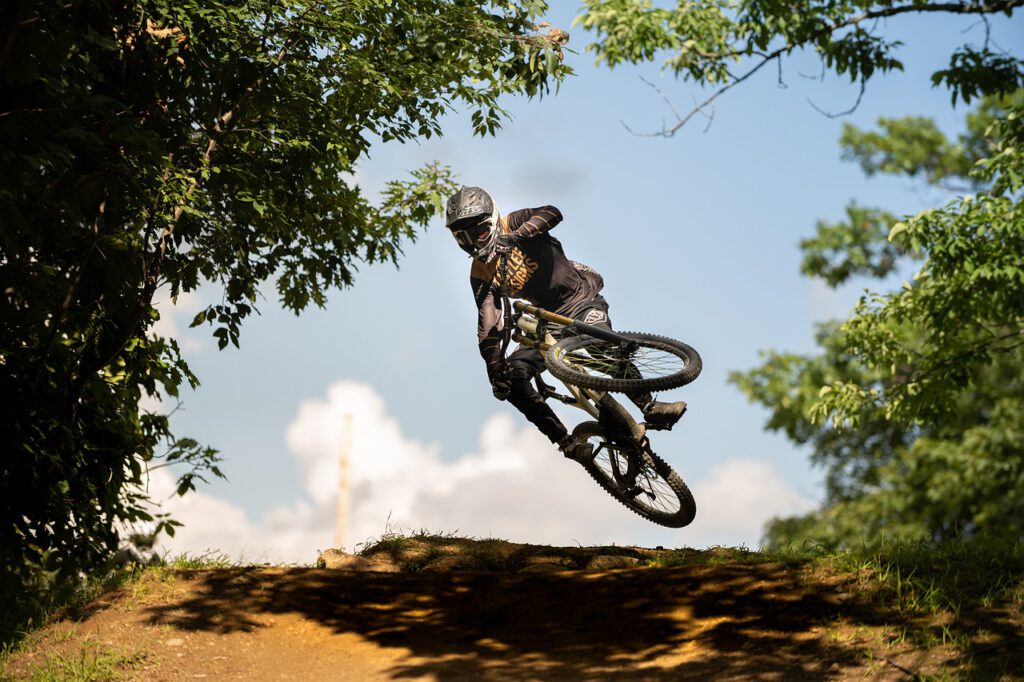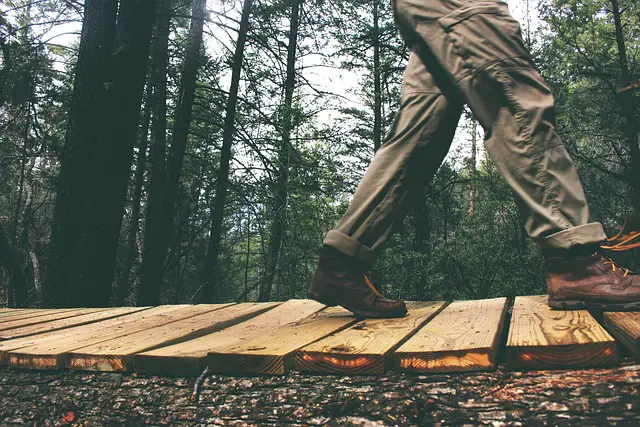Downhill mountain biking is a sport that combines the use of mountain bikes and downhill racing. It can consist of reaching speeds as high as 70 mph (113 km/h) as the biker races down a trail with jumps, berms, and other obstacles. Mountain biking started in California in the 1970s and early 1980s. These initial bikes were very heavy, stable machines designed for use on mountain trails.

Table of Contents
History of competitive racing
Downhill racing began in the mid-1970s, when riders such as Anne-Caroline Chausson and Lucy Smith raced down mountain trails on modified road bikes. Originally known as “Peoples’ Races”, these downhill events attracted crowds of thousands because they were a novel way to explore a popular cycling spot. As time went on, riders began to invent and build specialized bikes that would allow them to descend the steep trails more quickly. In 1990, Greg Herbold set a world record of 63.97 seconds on a used freeride bike at a professional downhill event in Mammoth Lakes, California.
There are many different types of competitive mountain biking including cross-country (XC), also known as endurance or long distance; gravity enduro (often shortened to enduro); dual slalom; super D; downhill (DHI/DH); four-cross (4X) usually held on an extreme course sometimes in the mountains; pump track racing; trials which involves navigating over various obstacles without putting your foot down on the ground or catching your pedal on anything above the ground; and cross-country eliminator (XCE), which is an extreme version of 4X.
Cross-country (XC)
is a genre of mountain biking practiced on an off-road bicycle trail. It is widely considered the most physically demanding form and has some downhill and dirt jumping elements. Cross-country riding is perceived to be more difficult than freeride and downhill due to its sustained aerobic nature. The XC discipline requires that riders navigate over roots, rocks, fallen leaves, mud, sand, loose uphill sections as well as steep hills with fine gravel or dirt surfaces. Since cross-country bicycles do not perform well on technical descents, the rider endurance aspect distinguishes it from all mountain biking (AM), which also includes downhill elements in addition to climbing skills.
XC bikes are characterized by relatively low suspension compared to downhill bikes while using knobby pneumatic off-road tires. Wheel size for a cross-country mountain bike is typically 26 inches (660 mm) or 27.5″ (700c), although 650b wheels have become popular in the more ‘freeride’ orientated scenes of Europe and Australia, while 29ers are gaining popularity among some riders, though others argue that it’s easier to ride a smaller wheel with good technique than a bigger wheel with improper technique. XC bikes also tend to have relatively low travel compared to downhill bikes, often 80–100 millimeters/3.15″-4.72″.
The suspension systems on most high quality cross country bikes are usually air sprung but some models use coil springs. All components except disc brakes must be easily serviceable on a trail for quick repairs.
Recently, companies have introduced the 29″ wheel in the XC market. The 29ers are generally faster on hard-pack terrain and provide greater carrying capacity but smaller wheels tend to be less stable at higher speeds than the traditional 26″/27.5″ setup. Some riders will fit knobby tires designed for dirt jumping to their bikes (eMTBs) which allows them to ride trails more technical than they would otherwise feel comfortable riding due to their lower ground clearance compared to pure cross country bikes or eBikes.
XC racing is very different from trail riding, since racers focus on speed rather than dealing with challenging obstacles. Races vary in length from 15 minutes plus 5 laps, a standard race, to 100 minutes plus 10 laps. For a race of a specified length, the number of laps determines the length of sections that are allowed for racing; sections are usually 2–3 km in urban areas and up to 25 km in wilderness terrain. The winner is determined based on the lowest time over a set distance or race course. There is also a team relay where four-person teams consisting of two men and two women alternate cross country racing with each rider completing one lap at their pace until all riders have competed once over the course (3.5 miles).
Gravity enduro
Gravity enduro is a relatively new racing format that combines downhill riding with cross country pedaling. This has created a very different bike setup compared to the traditional XC bike where emphasis is placed on climbing fast while maintaining high speed in descents, while Gravity Enduro places more emphasis on descending skills while climbing may be slower than other cross country race formats.
Bikes are completely stock except for modifications to smooth out the frame for descending or adding protection against rock strikes. Brakes are not allowed except at World Cup level races.
Trail riding involves negotiating tougher obstacles such as roots and rocks so riders should have good all-round mountain biking skills including strength, balance, coordination and body awareness (the ability to keep one’s feet over the tires). Riders will negotiate a variety of natural features such as dirt jumps, rock gardens and log piles. Trail riding is not exclusively performed on mountain bikes but because of the speed they can attain downhill compared to cross country bikes, riders often use specially designed bikes with front and rear suspension, larger frame geometry for stability at higher speeds, strong brakes and low gears.
Dual slalom
Dual slalom is a form of bicycling racing involving two riders competing head to head on identical courses with the objective being to complete the course faster than your opponent. Riders are allowed two runs, in which they cannot see their competitor’s run until it is finished, in an event that requires competitors to go up one side of the mountain and down the other in what is referred to as a ‘true’ dual slalom race.
This type of racing began on hills where there was little room for error, so if you get pushed off line by another rider you get added time for penalty laps. This format has evolved over time into the modern downhill type courses used today. The resulting action makes this kind of bicycle racing very spectator friendly.
Dual slalom courses are pre-designed and built specifically for racing, usually with man made features such as jumps, berms and other obstacles which can change the direction of the course abruptly. The tracks are so designed to keep speeds reasonably low on most of the course but still fast enough to allow racers to reach speeds in excess of 80kph (50mph).
Super D
Super D is a racing format that combines the downhill sections of cross country courses with an uphill slalom race on a less technical course. The riding position for this type of event allows more pedaling than pure gravity enduro or downhill types of racing. This has created a very different bike setup compared to the previous types where emphasis is placed on climbing fast while maintaining high speed in descents, while Super D places more emphasis on descending skills while climbing may be slower than other cross country race formats.
Downhill (DHI/DH)
Downhill racing features a timed race from the top of a mountain to the bottom. DH courses are steep, rough, and rocky with dramatic elevation changes. A DH bike has enough travel in its suspension to absorb some of the rocks and bumps on the downhill sections without bottoming out or being inefficient uphill. This is accomplished by sacrificing some climbing ability in favor of efficiency on the downhills making them lighter weight with better suspension. Bikes used in NICA sanctioned races may not exceed 6” travel nor have more than four inches of suspension travel total (bikes with 29″ wheels).
Four-cross (4X)
Four cross is a mountain bike racing game involving four riders on each heat. The main intention for this kind of sport is to use the uneven terrain to make jumps, berms and other features which are typically used in downhill-type bikes. Riders attempt to be first past the finish line after all 4 riders have completed their laps. It is not without danger as accidents can happen particularly when two or more riders come together at high speeds.
Pump track racing
This is a form of extreme Mountain biking that takes place within a manmade jump track. The word pump-track itself derives from pumping or gaining momentum while riding up and down the various undulations found in the track. Riders will use all kinds of body movements to maintain speed around the track, including jumps, berms, skips and hops.
Riders may choose to ride standard mountain bikes or BMX style bikes for racing purposes because they are known to be more agile due to their lighter weight compared with downhill bikes which are typically modified cross country or all-mountain downhill bikes. However riders will often use suspension components taken from both types of bicycles in order to increase performance between courses where come into play.
Cross-country eliminator (XCE)
This is a timed event over one lap of a course which typically takes 20 minutes to complete. The XCE format features riders competing against the clock rather than directly against other riders. It does not necessarily result in faster speeds compared with cross country racing, but it makes for an exciting spectator sport because there are many short powerful bursts of energy expended by each rider and most laps feature at least one significant bottleneck section where only one or two racers can pass through at a time.
FAQ About Downhill Mountain Biking
Is downhill mountain biking hard?
It is not hard as long as you have a secure place to practice and a basic understanding of the techniques involved.
What is downhill mountain biking called?
Downhill mountain biking is also known as free-ride, downhill-freeride, all mountain and extreme riding.
Is downhill mountain biking good exercise?
Yes downhill mountain biking is good exercise. It is a great way to get an intense workout that builds muscle and that uses most of your body muscles.
Can you downhill on a mountain bike?
Yes you can downhill on a mountain bike. There are special bikes for this purpose called downhill mountain bikes that are made to be stronger and more durable than regular mountain bikes.
Can I use downhill bike for trails?
No you should not use a downhill mountain bike for trails, because downhill bikes are specially designed for one type of riding. Downhill bikes are very heavy and lack the suspension to climb or corner well.
What is the difference between a mountain bike and a downhill bike?
A downhill bike is usually much heavier than a mountain bike because it needs to be strong and durable. A downhill bike also has better suspension, more gears, disk brakes and pedals that face the opposite direction.
Are downhill bikes good for jumping?
No downhill bikes are not good for jumping because they are too heavy. Jumping on a downhill bike is possible, but it would require you to lift up the front wheel and do an awkward bunny hop.
Can a downhill bike be your only bike?
No they are not. Downhill bikes are built for free-ride, which is one type of mountain biking. You would need at least two bikes to cover all the types of riding you might want to do in different locations or on different trails.



